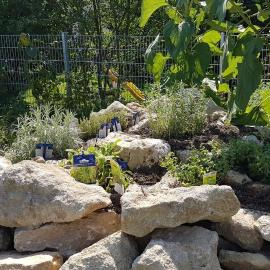 Montessori education is based on the principle: "Help me to do it myself!", which means that the pupils carry out practical work as independently as possible. It is important that the children and young people develop a holistic relationship with nature and understand it as a habitat, and basis of life. In the near future, topics relating to water and soil, biodiversity, climate, etc. will become increasingly important, which is why it is particularly important to familiarize young people with the complexity of the ecosystem in a practical way.
Montessori education is based on the principle: "Help me to do it myself!", which means that the pupils carry out practical work as independently as possible. It is important that the children and young people develop a holistic relationship with nature and understand it as a habitat, and basis of life. In the near future, topics relating to water and soil, biodiversity, climate, etc. will become increasingly important, which is why it is particularly important to familiarize young people with the complexity of the ecosystem in a practical way.
A school garden can be used across all subjects, for example, it offers reading corners, space for art projects (woodworking, sculptures, concrete casting), observing animals, insects, plants and much more. In the afternoons, pupils also work in the garden as part of the afternoon clubs. This means that the garden is also used by many pupils outside of school hours. Through school gardening, pupils learn to treat nature as a resource, with care. Based on this, they can expand their biological knowledge and pursue far-reaching questions, such as, How are plants structured? How can they be categorized? What are their growing conditions like? They experience how laborious and time consuming gardening is, and the amount of time, effort, and care needed for something to grow. These children and young people are less likely to carelessly destroy beds and plants, because they have learned to appreciate their value and take responsibility for them.
Twice a year, the school garden is made "fit for winter or summer" by all members of the school community as part of action days. Many helpers lend a hand, and often using heavy equipment, prepare a good basis for the school garden which is then managed afterwards by the pupils.
Circulation 2017 - Art on the building for the new building of the Bilingual Montessori School Ingelheim/Rhine by Barbara Wille
The passage of a year, and the passing of a day are often visualized in the image of a circle. The hands of the clock circle around the round dial, and divide the continuous duration of the days into countable and distinguishable time segments. The image of the circle also reflects the cosmic dynamics that create the constant change of the times of day and seasons: the rotation of the earth, and the orbit of the earth around the sun.
Pupils also experience the school year, and each individual school day as a very specific, repetitive sequence of events and time periods.
In the open-air playground of the Bilingual Montessori School in Ingelheim, the circular track gives the children a very direct, physical experience of the theme of the cycle and the relationship between time, space and the individual.
The four elements are assigned to the four cardinal points and the four seasons. The rising fiery orange of summer points south. An apple tree stands on the summit as a symbol of maturity and transition. Over the shaded side of the hill, the path descends in muted autumn tones into a hollow. On the cold blue of the water, past the cistern hill in the north, it goes through the winter and then up again to the west. From the airy crest of the hill, the spring wind announces the coming warmth with cheerful shades of green and yellow. The cherry tree on the central hill is a symbol of blossoming and also refers to the region with its old fruit trees.
The multi-colored track runs over the hills and hollows of a gently shaped landscape. With its two amplitudes, it adapts to the terrain and makes the different levels and gradients visible and tangible. The colors of the individual segments blend into a chromatic color space in the eye of the runner, as he or she runs along the track.
The colored fields give the impression of a game whose rules can be reinvented again and again. The surface is soft, elastic and comfortable. Jumping, running, walking and sitting never get old. Experiencing your own movement is continually new and different. The landscape dances in a supple and lively way and if you fall down, it doesn't hurt so much.
Photos: Thilo Folkerts
Type: Circular running track with springy surface, earth modeling, two fruit trees
Implementation planning and site management: 100Landschaftsarchitektur Thilo Folkerts
Collaboration: Adriaan Klein






